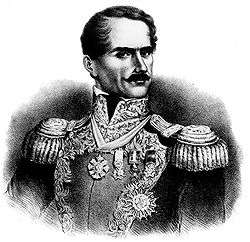Mexican Armed Forces
The Mexican Armed Forces (Fuerzas Armadas de México) are composed of two independent entities: the Mexican Army and the Mexican Navy. The Mexican Army includes the Mexican Air Force (FAM). The Special Forces are part of the Army while the Presidential Guard and Military Police fall under the National Guard, but have their own chain of command. The Mexican Navy includes the Naval Infantry Force (Marine Corps) and the Naval Aviation (FAN).
| Mexican Armed Forces | |
|---|---|
| Fuerzas Armadas de Mexico | |
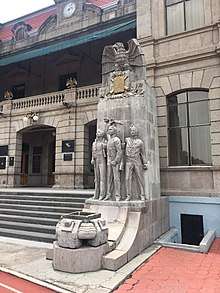 Monument to the Boy Heroes at the Mexican Military Academy | |
| Founded | 1821 |
| Service branches | |
| Headquarters | |
| Leadership | |
| Commander-in-chief | |
| Secretary of National Defense | |
| Secretary of the Navy | |
| Manpower | |
| Military age | 16–49[1] |
| Conscription | No |
| Active personnel | 277,150[2] (ranked 18th) |
| Reserve personnel | 81,500[2] |
| Expenditures | |
| Budget | US$7 billion (2019)[3] |
| Percent of GDP | 0.6% (2014 est.) |
| Industry | |
| Foreign suppliers | |
| Related articles | |
| Ranks | Army ranks Navy ranks |
The Army and Navy are controlled by two separate government departments, the National Defense Secretariat and the Naval Secretariat, and maintain two independent chains of command, with no joint command except the President of Mexico.
Organization
The Army
There are three main components of the Army: a national headquarters, territorial commands, and independent units. The Secretary of National Defense commands the Army by means of a very centralized system and a large number of general officers. The Army uses a modified continental staff system in its headquarters. The Army is the largest branch of Mexico's armed services.
Presently, there are 12 "Military Regions", which are further broken down into 44 subordinate "Military Zones." In both cases, a numbering system is used for designation. There is no set number of zones within a region, and these can therefore be tailored to meet operational needs, with a corresponding increase or decrease in troop strength.
The Air Force
The Air Force national headquarters is embedded in the Army headquarters in Mexico City. It also follows the continental staff system, with the usual A1, A2, A3, and A4 sections. The tactical forces form what is loosely called an Air Division, but it is dispersed in four regions: Northeast Mexico, Northwest Mexico, Central Mexico, and Southern Mexico. The Air Force maintains a total of 18 air bases, and has the additional capability of opening temporary forward operating bases in austere conditions for some helicopters and light aircraft.
The Navy
_(38866081012).jpg)
The Secretariat of the Navy, the Navy's national headquarters, is located in Mexico City, and is smaller than the Army's headquarters. The "Junta (or Council) of Admirals" plays a unique consultative and advisory role within the headquarters, an indication of the institutional importance placed on seniority and "year groups" that go back to the admirals’ days as cadets in the naval college. They are a very tightly knit group, and great importance is placed on consultation among the factions within these year groups. The Navy's operational forces are organized as two independent groups: the Gulf Force and the Pacific (West) Force. Each group has its own headquarters, a destroyer group, an auxiliary vessel group, a Marine Infantry Group, and a Special Forces group. The Gulf and Pacific Forces are not mirror images of each other, as independence of organization is permitted. Both are subdivided into regions, with Regions 1, 3, and 5 on the Gulf, and 2, 4, and 6 on the Pacific. Each region is further divided into sectors and zones, so a proliferation of headquarters and senior officers exists. The Navy also has an air arm with troop transport, reconnaissance, and surveillance aircraft.
The Navy maintains significant infrastructure, including naval dockyards that have the capability of building ships, such as the Holzinger class offshore patrol vessel. These dockyards have a significant employment and economic impact in the country.
The Marines
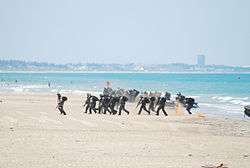
The Naval Infantry are the marine corps and amphibious infantry force of the Mexican Navy. The main task of the Infantería de Marina is to guarantee the maritime security of the country's ports and external and internal defense of the country, to accomplish these responsibilities the corps is trained and equipped to take on any type of operations from Sea, Air and Land.
The Naval Infantry Corps was reorganized in 2007–09 into 30 Naval Infantry Battalions, a paratroop battalion, a battalion attached to the Presidential Guard Brigade, two Fast Reaction Forces with six battalions each, and three Special Forces groups. The Naval Infantry are responsible for port security, protection of the ten-kilometer coastal fringe, and patrolling major waterways.
The Coast Guard
The Mexican Maritime Search and Rescue is the Mexican Navy's SAR Unit, which is responsible for improving the quality and effectiveness of the Navy's response to Mexico's maritime emergencies. The Mexican Navy historically has been responsible for the search and rescue operations using its available resources. However, aware of the importance of safeguarding human life at sea and the growing demand of sea rescue, the High Command of the Navy created the Maritime Search and Rescue unit.
Independent forces
.jpg)
Several other military organizations exist that are independent of the Army and Navy command structures.
Chief among the independent troops is an Army Corps consisting of two mechanized infantry brigades located in Mexico City plus a motorized brigade, with a full complement of combat and support troops. In addition, there are Special Forces units (1 division and more than 100 independent regional battalions) and a parachute brigade.
All these independent troops are located in Mexico City where they act as a ready reserve and as centers of excellence.
In times of need, a special "Rural Defense Corps" (or "Rurales") plays a role similar to a traditional volunteer militia (organized on an as-needed basis) in the rular communities. Today, Rural Defense teams work with both local law enforcement and the National Guard towards the goal of hindering organized crime and the threat of the drug cartels.
President Andres Manuel Lopez Obrador, in his inaugural message to the Armed Forces on 1 December 2018, officially asked the Congress of the Union to consider reactivating the National Guard of Mexico, this time, as a separate service of the armed forces under the direct control and responsibility of the Secretariats of National Defense and Public Security among similar lines as to the reorganized National Guard in France with a primary purpose to contribute to overall national defense and help protect the public order and safety, the relevant amendments to the Constitution were approved in March 2019 by both chambers.
Leadership
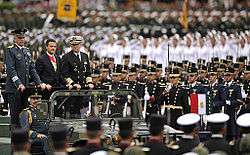
Officially, as there is no Minister of Defense, the Mexican military's two components are not under the command of a single commander except the President, who is Supreme Commander of the Armed Forces (Comandante Supremo De Las Fuerzas Armadas). According to the Constitution of Mexico the President is the Army's only five-star general. (This is comparable to most other countries with a presidential system of government, such as the United States.) Instead, a Secretary, who is a serving officer—an Army four-star general or a Navy admiral—heads each department and branch (The Secretariats of National Defense and the Navy). Each minister serves in a dual capacity: as a full cabinet member reporting to the President, and as the operational commander of their branch, but because of politics and rank, the Navy is subordinate to the Army.
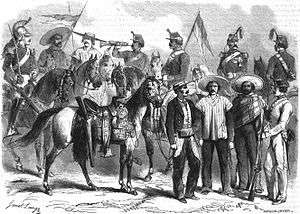
Moreover, the Air Force commander and his staff are attached to Army headquarters; no Air Force officer has risen to the hierarchy's most trusted, senior positions. This subordination has allowed the Army to identify its organization as the "Secretariat of National Defense" (Secretaría de la Defensa Nacional—SEDENA). As a result, the Army chief holds the nominal title of "Secretary of Defense."
The President picks the secretaries, who do not have to serve as such for his entire presidential term (sexenio, sexennium, six-year term). During the PRI's single-party rule, ministerial selection was a strict, pro-forma exercise by seniority. However, both Presidents Ernesto Zedillo (1994–2000) and Vicente Fox (2000–06) strayed from precedent and reached down to the junior levels to select "more progressive" officers to lead the forces.
The Army and the Navy are regionally organized, with central, national headquarters in Mexico City and subordinate, regional headquarters. Historically, this has proven to be effective because military's main deployments have been domestic. Troops are stationed throughout the country to serve as a continuing presence of authority and to allow for an immediate critical response. Dispersion by regional military zones has facilitated local recruitment of non-commissioned officers (Army sergeants, Navy petty officers) and enlisted men and women, allowing them to be stationed near family during their military service, an important cultural consideration. On the other hand, mobility is expected of commissioned officers to give them experience, and historically, to prevent any senior officer from remaining too long and becoming a warlord.
Personnel and budget
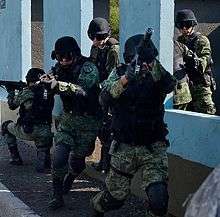
.jpg)
Per a defense ministry report written by General Guillermo Galván Galván, the Army has 700,000 active duty soldiers, and around about 350,00 reservist about 0.29 percent of the population. In 1989, its budget was 0.7 percent of the country's Gross National Product (GNP). In 1999, Mexico's military budget increased to 0.9 percent of its GDP, to US$4.0 billion. Since the year 2000, however, with the economic boost that the country has experienced, the defense budget was decreased to 0.5 percent of the GDP, and in 2007 had an annual expenditure of US$4 billion. Since President Calderón assumed office in December 2006, he has submitted legislation increasing the budget, in order to fight the drug war against the narcotics cartels, and narcotic drug trafficking in general, that have extended their violent business to each corner of the country. In 2012, Mexico spent US$7.1 billion on its military, amounting to 0.6 percent of GDP.
Since 2012, Mexico has spent over US$3 billion in equipment purchases as part of a modernization effort, including the purchase of Blackhawk helicopters.[4]
According to the CIA World Fact book, Mexico's available military manpower is 72,000,000 (males and females age 18–49, 2009 est.), with 58,000,000 fit for military service, and 2,638,214 annually reaching military service age. Since 2000, women have been allowed to volunteer for military service.
Although military service is mandatory for all 18-year-old males, recruitment for active-duty can only happen from ages 18 through 21 for those who have completed secondary education, and 22 for those who have only completed high school.
Mission
The Mexican Army works around three preparedness missions, or plans:
DN1: Preparation of the military forces to repel external aggressions. No military armed force can leave Mexican territory without a declaration of war, and approval of the Congress. The last time this was invoked was in 1942, to send an expeditionary force to the Philippines, after war was declared against Germany and Japan, following the sinking of two Mexican ships by U-boats. In 1990, President Carlos Salinas de Gortari asked the permission of the Congress to send troops to the Gulf War, but it was refused, since there was no declaration of war against Iraq.
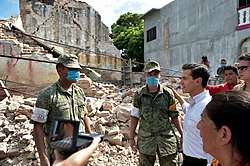
DN2: Preparation of the military forces to protect the internal security of the country. This would include police actions against guerrilla forces, counter-drug operations, and, originally, political control. Up to 1970, the Mexican Army had been used as a repressive force to maintain the virtual ruling party PRI government. The most controversial use of the military had been called "The dirty war" in the 1960s, which included the 1968 Tlatelolco massacre of students and unsuspecting bystanders. After 1980 these types of operations had nearly completely ceased (see EZLN).
DN3: (Defense against natural disasters). The Army should always be ready to help the civil population in case of disaster. This includes preventive measures. For example, between August and November, military forces are sent to Mexican coastal areas to aid the public in the event of hurricanes or floods. For the Mexican people, the DN3 plan is the most important peacetime operation of the Army. The Army provides food, shelter, medicine, and medical services to the people who need them. This also includes reconstruction of roads and communication services. Because calling the implementation DN3 plan is an acceptance of severe problems, the DN3 plan was not invoked in the 1985 Mexico City earthquake that left large areas of Mexico City in ruins, since the authorities did not want to recognize there was an emergency in the capital, while the army was called to the city, it was just a peacekeeping force. This later became a severe questioning on the government. The Mexican Army provided aid to the US following Hurricane Katrina. More recently, the DN3 plan was invoked in 2009 when an epidemic of swine flu threatened the population and in 2010 after the states of Veracruz, Tabasco, Nuevo León, Chiapas, Oaxaca and Guerrero were severely affected by floods caused by a number of hurricanes and tropical storms.
Conscription
Conscript soldiers
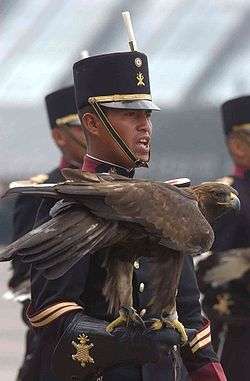
Legally, every Mexican man is obligated to a year of military service consisting of a few hours of drill or social services on weekends, not true military training. Most conscripts will have received at most only one marksmanship session at a rifle range by the time they have completed their service and are not integrated nor operate with regular army units.
The armed forces are generally made up of professionals. Military service age and obligation as of 2012 is 18 years of age for compulsory military service, conscript service obligation is 12 months; 16 years of age with consent for voluntary enlistment; conscripts serve only in the Army; Navy and Air Force service is all voluntary. Women are eligible for voluntary military service. Cadets enrolled in military schools from the age of 15 are considered members of the armed forces.[5]
The Cartilla
The drafted men attend and participate in weekend sessions that really are a social service in nature, with an emphasis being placed on education, history, physical fitness, and military discipline for one complete year. Afterward, the precartilla (pre-military identity card) is returned to the conscript with an added page certifying his status as having fulfilled his national military service and identifies the military branch, the unit, rank, etc. The document then acquires full status as the Cartilla del Servicio Militar Nacional (Military National Service Identity Card), informally Cartilla; this status is recorded in the National Defense and Navy Secretariats' files.
This document (Military National Service Identity Card) is an important form of Mexican national identification, and its existence was formerly always requested by private and public employers, however, this identity document has ceased being required for obtaining a passport for international travel.
Officers
Officer candidates for the three services are trained in military colleges; Mexico City for the Army, Guadalajara, Jalisco, for the Air Force, and Veracruz, for the Navy.
Career soldiers
Mexican citizens who have chosen to be career soldiers are signed for an initial 3-year contract and, at the end of it, are encouraged to sign for another 2-year contract. If they choose to do so, this 2nd term would become final, unless they undertake mandatory exams and tests to become corporals, or apply to study in any of the available Military Specialist Technical Schools or for sergeant in the E.M.C.A. (Escuela Militar de Clases de las Armas) (Army).
Limitations upon the military
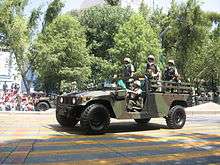
Article 129 of the 1917 Political Constitution of the Mexican United States establishes that: "No military authority may, in time of peace, perform any functions other than those that are directly connected with military affairs", but the Army's temporary replacement of civil police forces, in specific cases, before the creation of the Federal Police, has been much debated in Congress and in the mass communications media.
In a similar way in Article 26: "No member of the army shall, in time of peace, be quartered in private dwellings without the consent of the owner, nor may he impose any obligation whatsoever. In time of war the military may demand lodging, equipment, provisions, and other assistance, in the manner laid down in the respective martial law."
Military Law
As the President of Mexico is Commander in Chief of the armed forces, the chain of command and military discipline are subordinated to civilian control. Article 13 of the Mexican Constitution specifically provides for military jurisdiction over all military crime and discipline; military tribunals execute jurisdiction over military personnel, per the Uniform Code of Military Justice (UCMJ).
Regarding military personnel labor conditions, discipline, and the chain of command as fundamental to the military, Article 123-B establishes: "Military and naval personnel and members of the public security corps, and personnel of the foreign service, shall be governed by their own laws."
Public knowledge of the military's activities
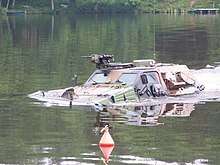
Historically, the mass communication media (television and print) have been restricted in their coverage of the military's ranks and their activities. Since 1995, the military has been placed under much domestic and international public scrutiny, increasing transparency.
The former defense ministers during President Fox's term, General Gerardo Clemente Vega and Admiral Peyrot, were considered progressive and academic in nature and background, though they remained in the monolithic image of the Mexican military man. The Mexican public have little insight to internal debate and dialogue within national military institutions; in public relations terms, both the Army and the Navy continue being reactive rather than proactive.
Activities outside Mexico
United Nations peacekeeping
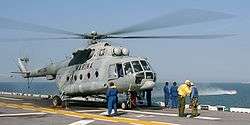
As of 2005, intervention in UN peacekeeping operations began being discussed, with strong resistance from some members of the Congress. However, in 2016 the first group of the Mexican Armed Forces joined MINUSTAH, the UN mission in Haiti: three officers (one from each service) as members of the mission's HQ, and two officers and one NCO attached to the Chilean battalion, by an agreement between the two countries. Mexican authorities have expressed their interest to increase their participation in the future.
Natural disaster relief
The Mexican Armed Forces has been deployed to several Central American countries to provide disaster relief, and most recently, to Indonesia after the tsunami disaster; only military support personnel were deployed, though, not combat forces. This includes the relief efforts in New Orleans after Hurricane Katrina. This was the first time the Mexican Army officially entered its former territory since the Mexican-American war. Mexican relief efforts were concentrated in Texas and New Orleans.
See also
- Army ranks and insignia of Mexico
- Brigada de Fusileros Paracaidistas
- Fuerzas Especiales
- Grupo Aeromóvil de Fuerzas Especiales
- Grupo Aeromóvil de Fuerzas Especiales del Alto Mando
- Ixtoc-Alfa
- Mexican Air Force
- Mexican military ranks
- Mexican response to Hurricane Katrina
- Mexican Special Forces
- Military history of Mexico
References
- "CIA – The World Factbook – Mexico". Central Intelligence Agency. Retrieved 2009-11-24.
- IISS 2018, pp. 411-412
- "Data" (PDF). www.sipri.org.
- Partlow, Joshua (15 June 2015). "What's behind Mexico's military buying binge?". Washington Post. United States. Retrieved 15 June 2015.
- "CIA – The World Factbook – Mexico". Central Intelligence Agency. Retrieved 2015-02-23.
Bibliography
- International Institute for Strategic Studies (14 February 2018). The Military Balance 2018. London: Routledge. ISBN 9781857439557.
External links
- Entry for Mexico in the CIA World Factbook
- The Mexican Armed Forces in Transition – Jordi Díez and Ian Nicholls
- Sergio Aguayo Quezada (Editor) El Almanaque Mexicano. México: Editorial Hechos Confiables. 2000.
- Christopher F. Foss. (Editor) Jane's Pocket Book of Modern Tanks and Armored Fighting Vehicles. New York: Collier Books. 1974.
- Christopher F. Foss. Jane's Tank and Combat Vehicles Recognition Guide. New York: Harper Collins Publishers. 2000.
- Verónica Macías "Para Las Fuerzas Armadas y Justicia 150,326 mdp". El Economista Peridico de Negocios y Economia.
- (in Spanish) National Defense Secretariat.
- (in Spanish) Navy Secretariat.
- (in Spanish) http://www.fasoc.cl/files/articulo/ART4117e2978fedb.pdf
- (in Spanish) Unofficial Military Forum MEXICAN ARMED FORCES
- Photo Album of the Mexican Military from militaryphotos.net
- Photos/MEXICAN ARMY, NATIONAL MARINE AND AIR FORCE
- Video 2006 Mexican Forces Parade
| Wikimedia Commons has media related to Mexican Armed Forces. |
